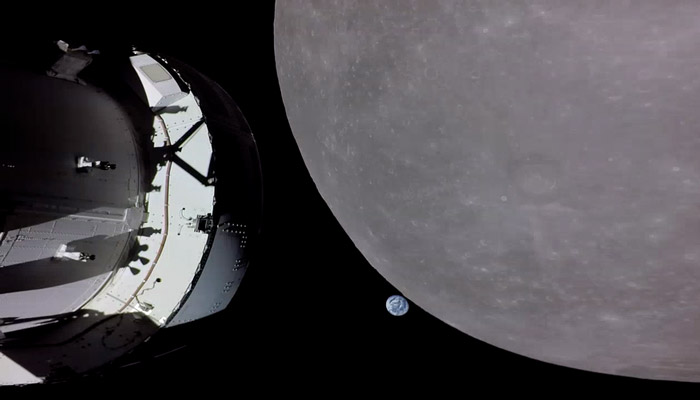The Orion spacecraft with European Service Module (left), Earth (middle) and the Moon (right) are captured in this ‘family portrait’ by Orion’s solar array camera during the spacecraft’s closet approach to the lunar surface.
Six days into the 25-day Artemis I mission, the Orion spacecraft performed a key manoeuvre: just a little more than 130 km from the lunar surface, the main engine on the European Service Module – a repurposed Space Shuttle engine that is now on its 20th spaceflight – fired for just under 150 seconds to push the spacecraft and head towards a lunar orbit using the Moon’s gravity to reduce fuel consumption.
The manoeuvre, known as the Outbound Powered Flyby, was another success for the Artemis I mission, whose goal is to test the mission profile, the spacecraft, and the people operating it in preparation for flights with astronauts on future missions.
The European Service Module is powering Orion around the Moon and back, providing propulsion, temperature control, electricity as well as storage and delivery for essential supplies such as fuel, water and air.
Mission control for Orion is at the Johnson Space Center in Houston, USA, where European engineers are on hand at all times to offer in-depth expertise on the finer details of the service module. The mission evaluation room based at ESA’s technical heart in The Netherlands also has personnel round the clock in direct communication with their US and European colleagues in mission control in Houston.
“Operationally the spacecraft is performing perfectly and the international collaboration with this new spacecraft with new flight rules is great to see,” says ESA’s Programme Manager for the European Service Modules, Philippe Deloo, “The teams across both sides of the Atlantic are showing exemplary skills, knowledge and teamwork leading humankind forward to the Moon.”
Stunning new imagery of Earth from a human-rated spacecraft such as this image is also important to the mission, bringing the wonder of space exploration to the public some 50 years after the last Apollo mission.
This photo was taken by a Go-Pro fastened to the end of one of four 7 m-long solar array, and connects to the spacecraft over a wireless network. The solar arrays provide enough electricity to power two households on Earth.
Find the latest updates on Artemis I on the ESA Orion blog and on Twitter @esaspaceflight.













